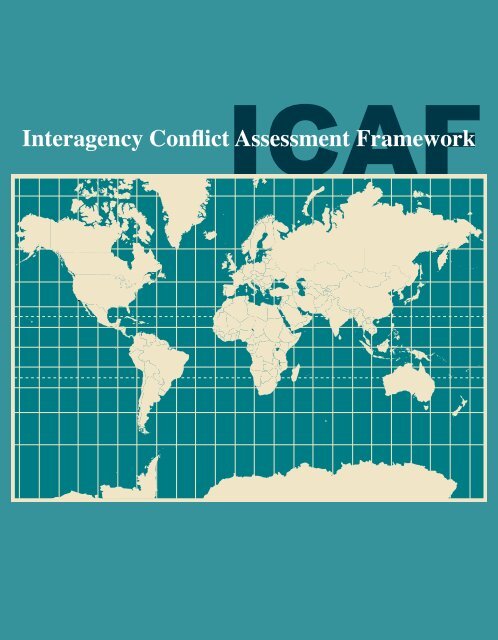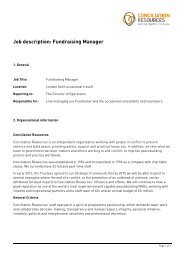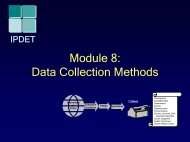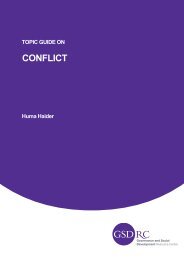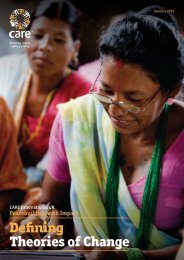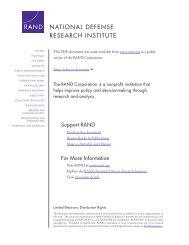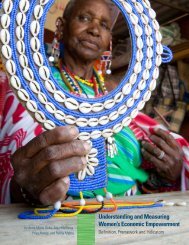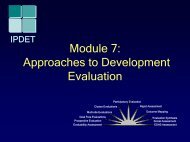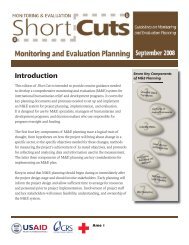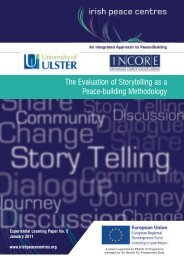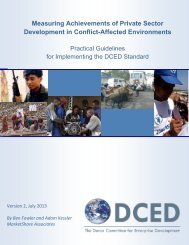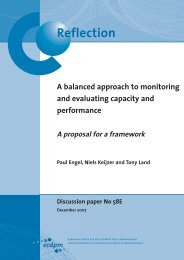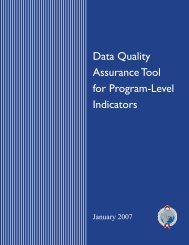Interagency Conflict Assessment Framework - US Department of State
Interagency Conflict Assessment Framework - US Department of State
Interagency Conflict Assessment Framework - US Department of State
Create successful ePaper yourself
Turn your PDF publications into a flip-book with our unique Google optimized e-Paper software.
ICAF<br />
<strong>Interagency</strong> <strong>Conflict</strong> <strong>Assessment</strong> <strong>Framework</strong><br />
i
Creating the ICAF<br />
The ICAF was created by a <strong>US</strong>G interagency working group,<br />
formed under the auspices <strong>of</strong> the Reconstruction and Stabilization<br />
Policy Coordinating Committee (R&S PCC). The <strong>Department</strong><br />
<strong>of</strong> <strong>State</strong>’s Office <strong>of</strong> the Coordinator for Stabilization and<br />
Reconstruction and <strong>US</strong>AID’s Office <strong>of</strong> <strong>Conflict</strong> Management<br />
and Mitigation co-chaired the Working Group that also included<br />
representatives from the Office <strong>of</strong> the Secretary <strong>of</strong> Defense,<br />
Joint Forces Command and the Army’s Peacekeeping and<br />
Stability Operations Institute.<br />
In May 2008, the Working Group successfully piloted the ICAF<br />
in a Washington, DC-based Application Workshop on Tajikistan<br />
with 18 representatives from various <strong>of</strong>fices within <strong>US</strong>AID and<br />
the <strong>Department</strong>s <strong>of</strong> <strong>State</strong>, Defense, Agriculture and Treasury.<br />
In July 2008, the R&S PCC adopted the Principles <strong>of</strong> the ICAF<br />
document published here.<br />
1
Contents<br />
What is the ICAF?........................................ 1<br />
Purpose <strong>of</strong> the ICAF..................................... 2<br />
When to Use the ICAF................................. 3<br />
Roles and Responsibilities.............................5<br />
How to Conduct an ICAF............................. 6<br />
Task One.............................................. 6<br />
Task Two.......................................... ..15<br />
Conclusion.................................................. 17<br />
2
What is the ICAF?<br />
A conflict assessment tool for the <strong>US</strong>G<br />
Addressing the causes and consequences <strong>of</strong> weak and failed states has become<br />
an urgent priority for the U.S. Government (<strong>US</strong>G). <strong>Conflict</strong> both contributes to<br />
and results from state fragility. To effectively prevent or resolve violent conflict,<br />
the <strong>US</strong>G needs tools and approaches that enable coordination <strong>of</strong> U.S. diplomatic,<br />
development and military efforts in support <strong>of</strong> local institutions and actors seeking<br />
to resolve their disputes peacefully.<br />
A first step toward a more effective and coordinated response to help states prevent,<br />
mitigate and recover from violent conflict is the development <strong>of</strong> shared understanding<br />
among <strong>US</strong>G agencies about the sources <strong>of</strong> violent conflict or civil strife.<br />
Achieving this shared understanding <strong>of</strong> the dynamics <strong>of</strong> a particular crisis requires<br />
both a joint interagency process for conducting the assessment and a common<br />
conceptual framework to guide the collection and analysis <strong>of</strong> information. The<br />
<strong>Interagency</strong> <strong>Conflict</strong> <strong>Assessment</strong> <strong>Framework</strong> (ICAF) is a tool that enables a team<br />
comprised <strong>of</strong> a variety <strong>of</strong> <strong>US</strong>G agency representatives (“interagency”) to assess<br />
conflict situations systematically and collaboratively and prepare for interagency<br />
planning for conflict prevention, mitigation and stabilization.<br />
This document summarizes and contains the<br />
key principles <strong>of</strong> the ICAF<br />
For more information or to arrange for an ICAF, please contact<br />
S/CRS at ICAF@state.gov or at 202-663-0302<br />
www.crs.state.gov<br />
1
Purpose <strong>of</strong> the ICAF<br />
It is essential for international actors to understand the specific context in<br />
each country, and develop a shared view <strong>of</strong> the strategic response required.<br />
- Principles for Good International Engagement in Fragile <strong>State</strong>s and<br />
Situations, OECD, 2007<br />
The purpose <strong>of</strong> the ICAF is to develop a commonly held understanding, across<br />
relevant <strong>US</strong>G <strong>Department</strong>s and Agencies <strong>of</strong> the dynamics driving and mitigating<br />
violent conflict within a country, that informs <strong>US</strong> policy and planning decisions.<br />
It may also include steps to establish a strategic baseline against which <strong>US</strong>G engagement<br />
can be evaluated. It is a process and a tool available for use by any <strong>US</strong>G<br />
agency to supplement interagency planning.<br />
This document outlines the key concepts, processes and products essential to the<br />
conducting <strong>of</strong> an ICAF analysis. Supplementary documents will be developed to<br />
provide a fuller treatment <strong>of</strong> the analytical framework, appropriate tools and data<br />
collection methods, and the composition and functioning <strong>of</strong> an <strong>Interagency</strong> <strong>Conflict</strong><br />
<strong>Assessment</strong> Team.<br />
The ICAF draws on existing methodologies for assessing conflict that are currently<br />
in use by various <strong>US</strong>G agencies as well as international and non-governmental<br />
organizations. The ICAF is not intended to duplicate existing independent analytical<br />
processes, such as those conducted within the intelligence community. Rather,<br />
it builds upon those and other analytical efforts to provide a common framework<br />
through which <strong>US</strong>G agencies can leverage and share the knowledge from their own<br />
assessments to establish a common interagency perspective.<br />
The ICAF is distinct from early warning and other forecasting tools that identify<br />
countries at risk <strong>of</strong> instability or collapse and describe conditions that lead to<br />
outbreaks <strong>of</strong> instability or violent conflict.<br />
2
The ICAF builds upon this forecasting by assisting an interagency team in understanding<br />
why such conditions may exist and how to best engage to transform them.<br />
To do so, the ICAF draws on social science expertise to lay out a process by which<br />
an interagency team will identify societal and situational dynamics that are shown<br />
to increase or decrease the likelihood <strong>of</strong> violent conflict. In addition, an ICAF<br />
analysis provides a shared, strategic snapshot <strong>of</strong> the conflict against which future<br />
progress can be measured.<br />
When to Use the ICAF<br />
An ICAF analysis should be part <strong>of</strong> the first step in any interagency planning<br />
process to inform the establishment <strong>of</strong> <strong>US</strong>G goals, design or reshaping <strong>of</strong> activities,<br />
implementation or revision <strong>of</strong> programs, or re/allocation <strong>of</strong> resources. The interagency<br />
planning process within which an ICAF analysis is performed determines<br />
who initiates and participates in an ICAF analysis, time and place for conducting<br />
it, type <strong>of</strong> product needed and how the product will be used, and the level <strong>of</strong> classification<br />
required.<br />
Whenever the ICAF is used, all <strong>of</strong> its analytical steps should be completed;<br />
however, the nature and scope <strong>of</strong> the information collected and assessed may be<br />
constrained by time, security classification or access to the field.<br />
3
Steady-<strong>State</strong> Engagement / <strong>Conflict</strong> Prevention Planning:<br />
May include, but is not limited to: Embassy preparation for National Defense<br />
Authorization Act (NDAA) Section 1207 funding; request by an Embassy or<br />
Combatant Command for interagency assistance in understanding and planning for<br />
leveraging <strong>US</strong> interests in fragile or at-risk countries; development <strong>of</strong> <strong>Department</strong><br />
<strong>of</strong> Defense (DoD) Theater Security Cooperation Plans; development <strong>of</strong> Country<br />
Assistance Strategies or Mission Strategic Plans; designing interagency prevention<br />
efforts for countries listed on <strong>State</strong> Failure Watchlists and Early Warning Systems.<br />
In a steady-state or conflict prevention effort, there normally will be sufficient time<br />
and a sufficiently permissive environment to allow a full-scale assessment such as<br />
a three-day Washington, DC-based Application Workshop and several weeks <strong>of</strong> an<br />
in-country verification assessment.<br />
<strong>US</strong>G R&S Contingency Planning:<br />
Is based on a hypothetical future, an ICAF analysis provides relevant background<br />
concerning existing dynamics that could trigger, exacerbate or mitigate violent<br />
conflict. The ICAF analysis should be a robust element <strong>of</strong> Contingency planning<br />
by providing critical information for the situation analysis. A three-day<br />
Washington, DC-based Application Workshop and/or an in-country verification<br />
assessment might prove useful when conducting an ICAF analysis as part <strong>of</strong> this<br />
planning process. Contingency Planning is defined in “Triggering Mechanisms for<br />
‘Whole-<strong>of</strong>-Government’ Planning for Reconstruction, Stabilization and <strong>Conflict</strong><br />
Transformation” and the “Principles <strong>of</strong> the <strong>US</strong>G Planning <strong>Framework</strong> for Reconstruction,<br />
Stabilization, and <strong>Conflict</strong> Transformation” (<strong>US</strong>G Planning <strong>Framework</strong>).<br />
These documents can be found at www.crs.state.gov.<br />
<strong>US</strong>G R&S Crisis Response Planning:<br />
Is also defined in the <strong>US</strong>G Planning <strong>Framework</strong>. The ICAF analysis provides<br />
critical information for the initial step <strong>of</strong> whole-<strong>of</strong>-government planning, the<br />
situation analysis. The ICAF analysis may be updated as more information and<br />
better access become available to inform policy formulation, strategy development<br />
and interagency implementation planning steps <strong>of</strong> the framework. When used for<br />
crisis response, the ICAF might be applied as a Washington, DC-based analysis that<br />
could be accomplished in as little as one and one-half days or, with longer leadtimes<br />
to the crisis, could take place over several weeks with conversations back and<br />
forth between Washington and any <strong>US</strong>G field presence.<br />
4<br />
4
Roles & Responsibilities<br />
The process within which an ICAF is used determines which agencies and<br />
individuals should serve on the team and in what capacities they should serve.<br />
For example, an established Country Team may use the ICAF analysis to inform<br />
Country Assistance Strategy development; the <strong>US</strong> Agency for International<br />
Development (<strong>US</strong>AID) and the <strong>Department</strong> <strong>of</strong> <strong>State</strong>’s Office <strong>of</strong> the Coordinator<br />
for Reconstruction and Stabilization (S/CRS) or a Regional Bureau may co-lead<br />
an interagency team performing an ICAF analysis to assist in developing a NDAA<br />
Section 1207 request; or the <strong>State</strong> Office <strong>of</strong> Political/Military Affairs or DoD may<br />
lead a team conducting an ICAF analysis to bring an interagency perspective to its<br />
theater security cooperation planning.<br />
In whole-<strong>of</strong>-government crisis response under the <strong>Interagency</strong> Management System<br />
for Reconstruction and Stabilization, an ICAF analysis normally will be part <strong>of</strong><br />
the strategic planning process led by the Country Reconstruction and Stabilization<br />
Group Secretariat. The ICAF might also be used with a key bilateral partner as<br />
part <strong>of</strong> collaborative planning. The agency/individual responsible for managing<br />
the overall planning process is responsible for proposing the ICAF and requesting<br />
necessary agency participation.<br />
As a principle, participants in an ICAF analysis should include the broadest<br />
possible representation <strong>of</strong> <strong>US</strong>G agencies with expertise and/or interest in a given<br />
situation. An ideal interagency field team would represent diverse skill sets and<br />
bring together the collective knowledge <strong>of</strong> <strong>US</strong>G agencies. Participants would at a<br />
minimum include relevant: regional bureaus, sectoral experts, intelligence analysts,<br />
and social science or conflict specialists. When used as part <strong>of</strong> the planning<br />
processes outlined in the <strong>US</strong>G Planning <strong>Framework</strong>, the team will include members<br />
<strong>of</strong> the strategic planning team. This team could be expanded as needed to include<br />
local stakeholders and international partner representatives.<br />
Members <strong>of</strong> the interagency team are responsible for providing all relevant information<br />
retained by their agency, including past assessments and related analyses, to<br />
the team for inclusion in the analysis. These representatives should also be able to<br />
reach back to their agencies to seek further information to fill critical information<br />
gaps identified through the ICAF process.<br />
5
How to Conduct An<br />
ICAF Analysis<br />
The ICAF can be used by the full range <strong>of</strong> <strong>US</strong>G agencies at any planning level.<br />
Conducting an ICAF analysis might be an iterative process with initial results built<br />
upon as the <strong>US</strong>G engagement expands. For example, an ICAF analysis done in<br />
Washington, DC at the start <strong>of</strong> a crisis might be enhanced later by a more in-depth<br />
examination in-country. The level <strong>of</strong> detail into which the ICAF analysis goes will<br />
depend upon the conflict and type <strong>of</strong> <strong>US</strong>G engagement.<br />
The two major components <strong>of</strong> the ICAF are the <strong>Conflict</strong> Diagnosis and the<br />
Segue into Planning.<br />
Task One: <strong>Conflict</strong> Diagnosis<br />
The first task in conducting an ICAF analysis is diagnosing a conflict.<br />
There are four steps involved in this process.<br />
Step One:<br />
Step Two:<br />
Step Three:<br />
Step Four:<br />
Evaluate the Context <strong>of</strong> the <strong>Conflict</strong><br />
Understand Core Grievances and<br />
Social/Institutional Resilience<br />
Identify Drivers <strong>of</strong> <strong>Conflict</strong> and<br />
Mitigating Factors<br />
Describe Opportunities for<br />
Increasing or Decreasing <strong>Conflict</strong><br />
6
CONTEXT<br />
INSTITUTIONAL PERFORMANCE<br />
SOCIETAL PATTERNS<br />
IDENTITY<br />
GROUPS<br />
KEY ACTORS’<br />
MOTIVATIONS AND<br />
MEANS<br />
WINDOWS OF<br />
VULNERABILITY<br />
WINDOWS OF<br />
OPPORTUNITY<br />
CORE GRIEVANCES<br />
SOCIAL AND INSTITUTIONAL RESILIENCE<br />
DRIVERS OF CONFLICT<br />
MITIGATING FACTORS<br />
OCCASIONS FOR INCREASING CONFLICT<br />
OCCASIONS FOR DECREASING CONFLICT<br />
Step One: Evaluate the Context <strong>of</strong> the <strong>Conflict</strong><br />
In order to determine the preceding elements <strong>of</strong> the conflict dynamic, the <strong>Assessment</strong><br />
Team should follow a series <strong>of</strong> analytical steps. First, the team should<br />
evaluate and outline key contextual issues <strong>of</strong> the conflict environment. Context<br />
does not cause conflict but describes <strong>of</strong>ten long-standing conditions resistant to<br />
change. Context may create pre-conditions for conflict by reinforcing fault lines<br />
between communities or contribute to pressures making violence appear as a more<br />
attractive means for advancing one’s interests. Context can shape perceptions <strong>of</strong><br />
identity groups and be used by key actors to manipulate and mobilize constituencies.<br />
Context includes, for example: environmental conditions, poverty, recent<br />
history <strong>of</strong> conflict, youth bulge, or conflict-ridden region.<br />
All ICAF steps begin with acknowledging the context within which the conflict<br />
arises. This is depicted in the graphic by placing each analytical task within a<br />
larger oval labeled “Context”. The arrows going in and out <strong>of</strong> the concentric<br />
circles, the triangle and the rectangle remind the analyst that context affects and is<br />
affected by each <strong>of</strong> the other components.<br />
7
Step Two: Understand Core Grievances<br />
and Social/Institutional Resilience<br />
The team should understand, agree upon and communicate the concepts <strong>of</strong> Core<br />
Grievance and Sources <strong>of</strong> Social/Institutional Resilience as defined here and<br />
describe them within the specific situation being assessed.<br />
Core Grievance: The perception, by various groups in a society, that their<br />
needs for physical security, livelihood, interests or values are threatened by one<br />
or more other groups and/or social institutions.<br />
Sources <strong>of</strong> Social/Institutional Resilience: The perception, by various groups<br />
in a society, that social relationships, structures or processes are in place and<br />
able to provide dispute resolution and meet basic needs through non-violent<br />
means.<br />
On the graphic on the proceeding page, the concentric circles labeled “Identity<br />
Groups,” “Societal Patterns” and “Institutional Performance” interact with the<br />
Context identified in Step 1. In Step 2, the <strong>Assessment</strong> Team should:<br />
1. Describe Identity Groups who believe others threaten their identity,<br />
security or livelihood:<br />
Identity Groups are groups <strong>of</strong> people that identify with each other, <strong>of</strong>ten<br />
on the basis <strong>of</strong> characteristics used by outsiders to describe them (e.g.,<br />
ethnicity, race, nationality, religion, political affiliation, age, gender,<br />
economic activity or socio-economic status); Identity Groups are inclined<br />
to conflict when they perceive that other groups’ interests, needs and<br />
aspirations compete with and jeopardize their identity, security or other<br />
fundamental interests.<br />
8
2. Articulate how Societal Patterns reinforce perceived deprivation, blame<br />
and inter-group cleavages and/or how they promote comity and peaceful<br />
resolution <strong>of</strong> inter-group disputes:<br />
Societal Patterns associated with conflict reinforce group cleavages,<br />
for example: elitism, exclusion, corruption/rent-seeking, chronic state<br />
capacity deficits (e.g., systematic economic stagnation, scarcity <strong>of</strong> necessary<br />
resources, ungoverned space), and unmet expectations (e.g., lack<br />
<strong>of</strong> a peace dividend, land tenure issues, disillusionment and alienation).<br />
Impacts <strong>of</strong> societal patterns <strong>of</strong>ten include negative economic consequences<br />
for disadvantaged groups.<br />
3. Explain how poor or good Institutional Performance aggravates or<br />
contributes to the resolution <strong>of</strong> conflict:<br />
Institutional Performance considers formal (e.g., governments, legal<br />
systems, religious organizations, public schools, security forces, banks<br />
and economic institutions) and informal (e.g., traditional mechanisms for<br />
resolving disputes, family, clan/tribe, armed groups and patrimonialism)<br />
social structures to see whether they are performing poorly or well and<br />
whether they contribute to conflict and instability or manage or mitigate<br />
it. In assessing institutional performance it is important to distinguish<br />
between outcomes and perceptions. Institutional outcomes are results that<br />
can be measured objectively; perceptions are the evaluative judgments <strong>of</strong><br />
those outcomes. Understanding how outcomes are perceived by various<br />
groups within a society, especially in terms <strong>of</strong> their perceived effectiveness<br />
and legitimacy, is an important component <strong>of</strong> conflict diagnosis.<br />
The <strong>Assessment</strong> Team completes Step 2 by listing Core Grievances and<br />
Sources <strong>of</strong> Social and Institutional Resilience.<br />
9
Step Three: Identify Drivers <strong>of</strong> <strong>Conflict</strong><br />
and Mitigating Factors<br />
The team should understand and outline Drivers <strong>of</strong> <strong>Conflict</strong> and Mitigating factors<br />
as defined here and enumerate those identified within the specific situation being<br />
assessed.<br />
Drivers <strong>of</strong> <strong>Conflict</strong>: The dynamic situation resulting from Key Actors’<br />
mobilization <strong>of</strong> social groups around Core Grievances. Drivers <strong>of</strong> <strong>Conflict</strong> can<br />
be understood as active energy, while Core Grievances are potential energy.<br />
Mitigating Factors: The dynamic situation resulting from Key Actors’ mobilization<br />
<strong>of</strong> social groups around Sources <strong>of</strong> Social/Institutional Resilience.<br />
Mitigating Factors can be understood as the kinetic energy produced when key<br />
actors mobilize the potential energy <strong>of</strong> Social and Institutional Resilience.<br />
In Step 3 <strong>of</strong> the analysis, the <strong>Assessment</strong> Team identifies Key Actors that are<br />
central to producing, perpetuating or pr<strong>of</strong>oundly changing the Societal Patterns or<br />
Institutional Performance identified in Step 2.<br />
The <strong>Assessment</strong> Team should identify whether Key Actors are motivated to mobilize<br />
constituencies toward inflaming or mitigating violent conflict and what means<br />
are at their disposal.<br />
To perform the analysis in Step 3, the <strong>Assessment</strong> Team should:<br />
10
1. Identify Key Actors:<br />
WHO: People, organizations or groups who, because <strong>of</strong> their leadership abilities<br />
and/or power (e.g., political position, moral authority, charisma, money,<br />
weapons):<br />
• Have an impact on Societal Patterns/Institutional Performance<br />
• Are able to shape perceptions and actions and mobilize people around<br />
Core Grievances or Social and Institutional Resilience<br />
• Are able to provide the means (money, weapons, information) to support<br />
other key actors who are mobilizing people around Core Grievances or<br />
Social and Institutional Resilience<br />
WHERE: Look for Key Actors in:<br />
• Leadership positions in governing, social or pr<strong>of</strong>essional organizations<br />
or networks (either within or external to a state or territory), including<br />
private business, religious organizations, government positions (including,<br />
police forces, judicial system and military), informal and illicit power<br />
structures, media and academic institutions<br />
WHAT & HOW: Understand Key Actors’ Motivations and Means by<br />
describing:<br />
• What motivates Key Actors to exert influence on each <strong>of</strong> the political,<br />
economic, social and security systems in a country or area<br />
• How they exert influence (e.g. leadership capacity, moral authority,<br />
personal charisma, money, access to resources or weapons, networks or<br />
connections)<br />
11
2. Determine Key Actors’:<br />
OBJECTIVES: that promote violence or promote peaceful alternatives and<br />
MEANS AND RESOURCES: that are available to actors to accomplish<br />
those objectives, including:<br />
• Capacity for violence/intimidation<br />
• Financial resources (including taxes, “protection” fees, support from<br />
external actors or parties)<br />
• Valuable primary commodities (labor, information, forest products,<br />
minerals, high value crops, etc.)<br />
• Control <strong>of</strong> media outlets<br />
• Mass support<br />
Using the information generated on Key Actors, the <strong>Assessment</strong> Team should<br />
draft brief narrative statements describing “why” and “how” Key Actors mobilize<br />
constituencies around Core Grievances and, separately, around sources <strong>of</strong> Social<br />
and Institutional Resilience. Each statement relating to Core Grievances becomes<br />
an entry in the list <strong>of</strong> Drivers <strong>of</strong> <strong>Conflict</strong> and each relating to sources <strong>of</strong> Social and<br />
Institutional Resilience becomes an entry in the list <strong>of</strong> Mitigating Factors.<br />
The <strong>Assessment</strong> Team completes Step 3 <strong>of</strong> the analysis by listing the Drivers <strong>of</strong><br />
<strong>Conflict</strong> and, separately, the Mitigating Factors by the strength <strong>of</strong> their impact<br />
on the conflict.<br />
12
Step Four: Describe Opportunities for Increasing or<br />
Decreasing <strong>Conflict</strong><br />
The team should specify near-term events or occasions likely to provoke negative<br />
or positive changes in the status quo. In the ICAF, these events are referred to as<br />
Windows <strong>of</strong> Vulnerability and Windows <strong>of</strong> Opportunity.<br />
Windows <strong>of</strong> Vulnerability: Windows <strong>of</strong> Vulnerability are moments when<br />
events threaten to rapidly and fundamentally change the balance <strong>of</strong> political or<br />
economic power. Elections, devolution <strong>of</strong> power and legislative changes are<br />
examples <strong>of</strong> possible windows <strong>of</strong> vulnerability. Key Actors may seize on these<br />
moments to magnify the Drivers <strong>of</strong> <strong>Conflict</strong>.<br />
Windows <strong>of</strong> Opportunity: Windows <strong>of</strong> Opportunity are moments when<br />
over-arching identities become more important than sub-group identities, for<br />
example, when natural disaster impacts multiple groups and requires a unified<br />
response. These occasions may present openings for <strong>US</strong>G efforts to provide<br />
additional support for a conflict’s Mitigating Factors.<br />
13
In Step 4 the <strong>Assessment</strong> Team should:<br />
1. Identify potential situations that could contribute to an increase in violent<br />
conflict.<br />
• Windows <strong>of</strong> Vulnerability are potential situations that could trigger escalation<br />
<strong>of</strong> conflict (e.g., by contributing to confirmation <strong>of</strong> the perceptions<br />
underlying Core Grievances), and <strong>of</strong>ten result from large-scale responses<br />
to: an increase <strong>of</strong> uncertainty during elections or following an assassination;<br />
an exclusion <strong>of</strong> parties from important events such as negotiations or<br />
elections; or attempts to marginalize disgruntled followers.<br />
2. Identify potential situations that might <strong>of</strong>fer opportunities for mitigating<br />
violent conflict and promoting stability.<br />
• Windows <strong>of</strong> Opportunity describe the potential situations that could<br />
enable significant progress toward stable peace (e.g., through conditions<br />
where Core Grievances can be reconciled and sources <strong>of</strong> Social and<br />
Institutional Resilience can be bolstered) such as those where overarching<br />
identities become important to disputing groups; where natural disasters<br />
impact multiple identity groups and externalities require a unified<br />
response; or a key leader driving the conflict is killed.<br />
The <strong>Assessment</strong> Team completes Step 4 by considering<br />
Windows <strong>of</strong> Vulnerability and Windows <strong>of</strong> Opportunity and prioritizing<br />
Drivers <strong>of</strong> <strong>Conflict</strong> and Mitigating Factors identified in Step 3.<br />
14
The <strong>Assessment</strong> Team uses the list <strong>of</strong> prioritized Drivers <strong>of</strong> <strong>Conflict</strong> and Mitigating<br />
Factors as the basis for its findings, whether those findings are, for example:<br />
priorities for the whole-<strong>of</strong>-government Assistance Working Group that is setting<br />
parameters for the <strong>State</strong> <strong>Department</strong>’s Office <strong>of</strong> the Director <strong>of</strong> Foreign Assistance’s<br />
Country Assistance Strategy; recommendations to a Country Team preparing an<br />
application for NDAA Section 1207 funding; or recommendations to a whole-<strong>of</strong>government<br />
<strong>US</strong>G R&S Crisis Response Planning or Contingency Planning team.<br />
Task Two: Segue into Planning<br />
When an ICAF analysis is undertaken to support <strong>US</strong>G R&S Crisis Response<br />
Planning or Contingency Planning, the findings <strong>of</strong> the conflict diagnosis feed into<br />
situation analysis and policy formulation steps <strong>of</strong> the planning process in the <strong>US</strong>G<br />
Planning <strong>Framework</strong>.<br />
When an ICAF analysis is undertaken to support interagency steady-state<br />
engagement or conflict prevention planning, after completing the diagnosis, the<br />
<strong>Assessment</strong> Team begins pre-planning activities. During the segue into these types<br />
<strong>of</strong> planning, the <strong>Assessment</strong> Team maps existing diplomatic and programmatic<br />
activities against the prioritized lists <strong>of</strong> Drivers <strong>of</strong> <strong>Conflict</strong> and Mitigating Factors.<br />
This activity identifies gaps in current efforts as they relate to conflict dynamics and<br />
is not intended as an evaluation <strong>of</strong> the overall impact or value <strong>of</strong> any program or<br />
initiative. The <strong>Assessment</strong> Team uses these findings as a basis for making recommendations<br />
to planners on potential entry points for <strong>US</strong>G activities.<br />
15
Steps for Steady-<strong>State</strong> Engagement and<br />
<strong>Conflict</strong> Prevention Planning<br />
Specify current <strong>US</strong>G activities (listing <strong>US</strong>G agencies present in the country<br />
and the nature and scope <strong>of</strong> their efforts)<br />
• Identify the impact <strong>of</strong> these efforts on Drivers <strong>of</strong> <strong>Conflict</strong> and Mitigating<br />
Factors<br />
• Identify other efforts targeting similar outcomes and whether coordination<br />
mechanisms are in place<br />
Specify current efforts <strong>of</strong> non-<strong>US</strong>G actors, including bilateral agencies,<br />
multi-lateral agencies, NGOs, the private sector and local entities<br />
• Identify the impact <strong>of</strong> the efforts on the Drivers <strong>of</strong> <strong>Conflict</strong> and Mitigating<br />
Factors<br />
• Identify other efforts targeting similar outcomes and whether coordination<br />
mechanisms are in place<br />
In addition, the team should also:<br />
• Identify Drivers <strong>of</strong> <strong>Conflict</strong> and Mitigating Factors not sufficiently<br />
addressed by existing efforts, i.e., gaps<br />
• Specify challenges to addressing the gaps<br />
• Referring to Windows <strong>of</strong> Vulnerability, describe risks associated with<br />
failure to address the gaps<br />
• Referring to Windows <strong>of</strong> Opportunity, describe opportunities to address<br />
the gaps<br />
The <strong>Assessment</strong> Team draws on the information generated in Task 2, Segue into<br />
Planning, to determine potential entry points for <strong>US</strong>G efforts. The description <strong>of</strong><br />
these entry points should explain how the dynamics outlined in the ICAF diagnosis<br />
may be susceptible to outside influence.<br />
16
Conclusion<br />
Completing an ICAF analysis should be your first step in understanding how to<br />
address a conflict. It is also important to remember that the shared perspective<br />
resulting from conducting an ICAF analysis is a snapshot <strong>of</strong> a particular situation<br />
that is constantly in flux. Optimal use <strong>of</strong> this tool provides for review <strong>of</strong> the situation<br />
using the same methodology on a regular basis. Even a single application<br />
<strong>of</strong> the ICAF provides policy-makers and practitioners alike a more robust and<br />
cohesive understanding <strong>of</strong> the dynamics driving and mitigating conflict.<br />
As with any tool, limitations to the ICAF are likely to be encountered the more it is<br />
used and we would like to receive suggestions for improving it.<br />
If you have any additional questions on how to use this tool, or would like to<br />
request assistance in conducting an ICAF, please contact S/CRS at ICAF@state.gov<br />
or at 202-663-0302. For additional information, please visit www.crs.state.gov.<br />
17
Office <strong>of</strong> the Coordinator for Reconstruction and Stabilization<br />
United <strong>State</strong>s <strong>Department</strong> <strong>of</strong> <strong>State</strong><br />
2121 Virginia Ave., NW<br />
Washington, DC 20037<br />
202.663.0323<br />
www.crs.state.gov<br />
20


